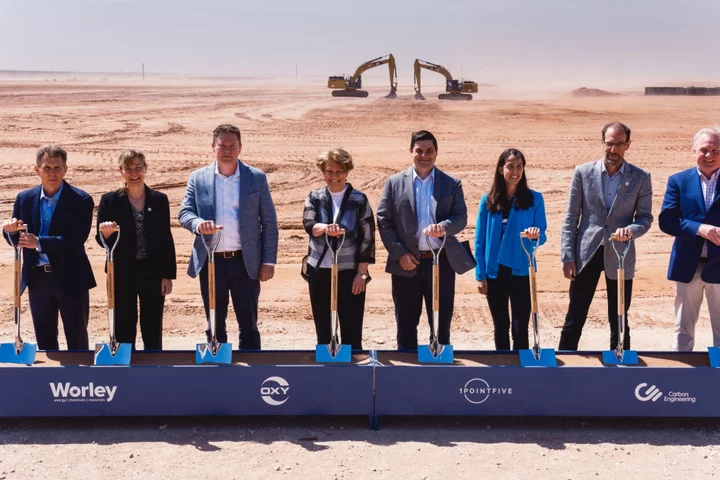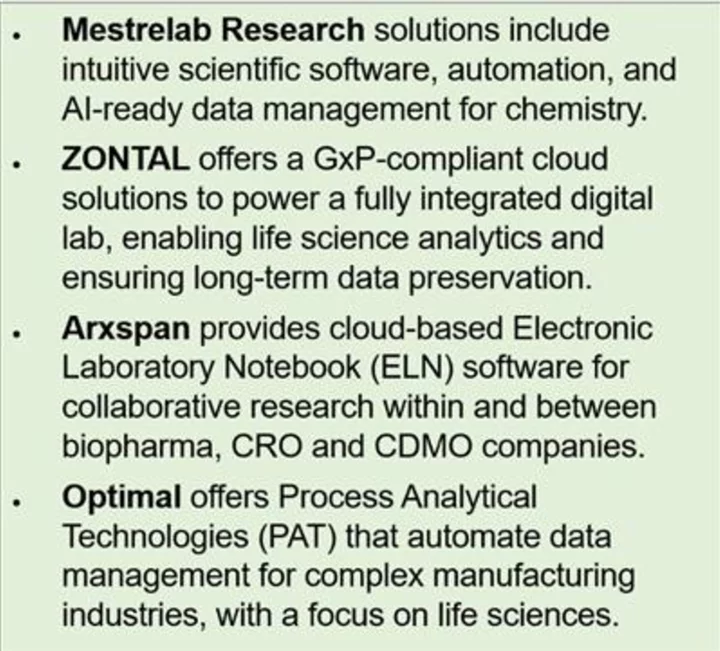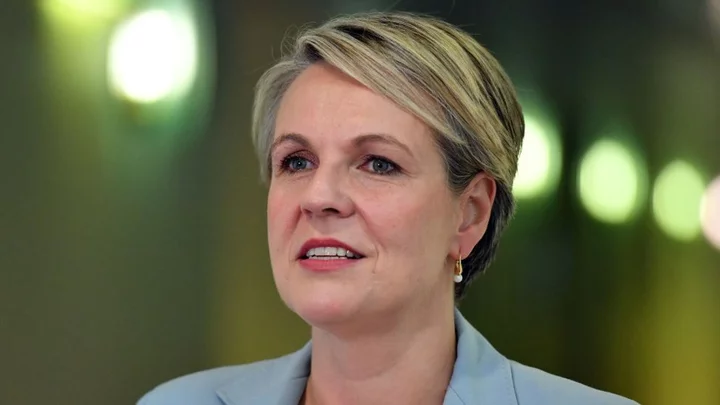When Occidental Petroleum Corp.’s Vicki Hollub introduced the idea of “net zero oil” two years ago, few outside the chief executive officer’s inner circle knew what she meant. It was easy for climate-minded critics to dismiss the rhetoric as a greenwashing ploy from an embattled oil executive trying to stay relevant in a world transitioning away from fossil fuels.
But Hollub’s vision keeps moving closer to reality. This month she helped convince the Biden administration — which has been hostile to Big Oil — to spend hundreds of millions of dollars on the technology behind the industry’s most ambitious moonshot to keep fossil fuels alive.
Occidental won one of two major US Department of Energy grants to develop hubs for direct air capture, or DAC. That means Occidental will be in charge of an experimental facility built in Kleberg County, Texas, designed to pull carbon dioxide from ambient air and bury it underground. Hollub followed this milestone federal grant days later by agreeing to a $1.1 billion deal to buy Carbon Engineering. The Canadian startup is Occidental’s technology partner on the government-backed project as well as another another DAC plant in West Texas that — according to the company’s claims — will produce emissions-free crude oil.
The speed with which Occidental and DAC has captivated the Biden administration is alarming for environmentalists and some scientists. DAC remains by far the most expensive way to capture carbon, and the technology is largely unproven outside one small plant in Iceland. There are serious questions about whether the large quantities of power the process needs will offset the climate benefits. The loudest critics insist DAC should never be used to justify fossil-fuel extraction.
“Occidental has great technical strengths, and there’s a strong case that we will need gigaton-scale carbon removal,” said Danny Cullenward, senior fellow at Kleinman Center for Energy Policy at the University of Pennsylvania. “But when you have an oil company whose leadership is vocal about DAC providing a social license to continue oil production 80 years in the future, it’s directly at odds with a strategy that gets us to climate stabilization.”
Occidental declined to comment for this story, but referred to Hollub's previous comments stating that Occidental is ready to meet whatever level of demand exists in the future with lower- or zero-emissions oil.
The company’s plan for carbon-removal technology reach far into the future. Occidental’s first DAC plant won’t be operational until 2025 at the earliest — yet in the 10 years that follow, it has ambitions to build 100 DAC plants. If it succeeds, Occidental will become a world leader in a carbon-removal market that could be worth $150 billion a year by 2050, according to BloombergNEF.
All while Hollub plans on using the promise of DAC to keep the core oil business thriving.
Carbon dioxide has been central to Occidental’s business for decades. Before it became a big US shale player over the past 10 years, the company would buy aging domestic oil fields from larger rivals. To squeeze out the last dregs of crude, Occidental would pump CO2 into wells in a process called enhanced oil recovery, or EOR, that’s been used since the 1970s. It was a dependable business that paired well with riskier bets overseas.
But when Hollub was general manager of Occidental’s Permian EOR operations in 2011, she realized the company was limited not by the amount of oil in the ground, but by the availability of CO2. It was an odd problem, particularly because global warming is chiefly caused by its abundance of in the atmosphere. Hollub figured that if there was a way of extracting that CO2 from the air, it would be good for business and the environment, she told Bloomberg Green’s Zero podcast last year.
The problem is that for CO2 to be useful — for oil recovery or any other industrial application, such as putting the fizz in soda drinks — it needs to be in a concentrated, pure stream. And despite a 50% rise in atmospheric CO2 since pre-industrial times, the planet-warming gas makes up only 0.04% of ambient air.
Around the same time, David Keith, then a professor at the University of Calgary, was working on that exact same problem: How to turn dilute CO2 in the air to a concentrated stream for industrial processes. His startup, Carbon Engineering, used giant fans and liquid solvents to filter the gas from the atmosphere and won backing from billionaires including Bill Gates and Canadian oil sands tycoon Murray Edwards.
Carbon Engineering’s successful pilot plant in 2015 quickly attracted the attention of Hollub and other oil executives, who liked the idea of a climate solution that didn’t pose a direct threat to their core business of selling fossil fuels. If a DAC plant could pump more CO2 into the ground than would be produced by the resulting barrel of crude, then that oil could be considered “net zero,” according to Hollub.
Occidental invested in Carbon Engineering alongside Chevron Corp. in early 2019, pledging to accelerate commercialization of the startup’s technology. In the intervening years, however, outside factors threatened to derail the whole project. That includes Oxy’s $55 billion acquisition of Anadarko Petroleum that sunk the company’s stock and incurred the wrath of activist investor Carl Icahn. Hollub survived calls for her resignation, only for Covid-19 and plunging oil prices to hammer the company’s stock once again in 2020.
Through it all, Hollub stuck with her commitment to carbon capture. Occidental became the first US oil company to lay out an “ambition” to become fully net zero by 2050, including customer emissions. That put it ahead of US peers like Exxon, Chevron and ConocoPhillips, which have so far declined such measures.
Occidental’s talk of zeroing-out emissions in 2020 came alongside a pledge to build the world’s largest DAC plant in the Permian Basin, using Carbon Engineering’s technology. “This not only helps us to help the world by reducing CO2 out of the atmosphere, it will help our shareholders too by lowering our costs of enhanced oil recovery,” Hollub said at the time.
“[W]hen you have an oil company whose leadership is vocal about DAC providing a social license to continue oil production 80 years in the future, it’s directly at odds with a strategy that gets us to climate stabilization.”
Hollub has been cautious so far about spending too much of Occidental’s own money. Instead, she put the company’s investment dollars into quicker-payback efforts such as drilling for oil in the Permian.
When US President Joe Biden took office, the oil industry saw a chance to gain support for carbon capture, which had backers on both sides of the aisle. Occidental spent more than $10 million on direct lobbying in both 2021 and 2022, an increase of more than half over the previous decade’s annual average, and more than both Exxon and Chevron.
The company was a big winner in both those years’ major pieces of legislation: the Bipartisan Infrastructure Law and the Inflation Reduction Act. The IRA’s tax credit for regular carbon capture — the type that gathers a concentrated stream of CO2 from a refinery smokestack, for example — increased 70% to $85 a ton. And the credit for DAC became even more generous, rising to $160 a ton.
By the time the IRA passed in August 2022, Occidental’s finances had improved thanks to rising oil prices. Hollub hailed the IRA as “a net very positive bill” for the company, and within months she was touting the potential of the company building 100 DAC plants. It will be another year at least before the first is built, meaning Occidental would have to construct nearly 10 each year to hit that target. Even if the initial plant and the government-backed DAC hub capture and bury 1 million tons of carbon a year each — the upper end of the target for Occidental’s first — they would negate less than 0.1% of US energy-related emissions.
Corporate polluters are already clamoring for the technology they view as being able to generate high-quality carbon credits to offset their own emissions. Already, companies such as All Nippon Airways, Airbus, Shopify and Thermo Fisher have bought carbon removal credits from 1PointFive, Oxy’s DAC subsidiary.
While Hollub sees major potential to grow this market, she also has the option of using the CO2 to produce more of Occidental’s lifeblood: crude oil.
“We need to extend the life of oil production, because it’s the most intensive energy source and so we need to do it for the world — it makes the world a better place,” she said on Bloomberg Green’s Zero podcast last year. “Too many people are focusing on killing energy sources, rather than killing emissions. The common enemy that we all have are the emissions.”
Hollub has said the company’s DAC strategy doesn't necessarily mean producing more oil. She wants her company to be ready to meet whatever level of demand exists in the future with lower- or zero-emissions oil. But there’s reason to worry that the promise deploying DAC tomorrow will come at the expense of emissions reductions today. Oil companies are some of the main culprits that have driven greenhouse gas emissions to record highs in the first place.
“We have, after all, been locked in a dirty energy economy for over 250 years since the time of the industrial revolution,” said Ben Kolosz, a carbon-removal expert at University of Hull’s Energy and Environment Institute. Oil companies need a “paradigm shift to occur” before people see them as manager of carbon dioxide, and that takes time. “But it will happen, it’s just a question of when.”
The oil industry is far from alone in seeing an enormous future for technologies that can pull CO2 from the air. No less an authority than the UN-backed scientists on the Intergovernmental Panel on Climate Change see carbon removal as crucial in in getting to net zero. So too do researchers at the International Energy Agency and within the US government. This is especially in sectors like plastics and aviation fuels that are hard to clean up through other means.
But if carbon removal is not paired with other, more decisive forms of emissions reduction, then it will be counterproductive, warned Andrew Logan, a senior director at Ceres, a nonprofit coalition of investors and companies advocating for sustainability. Logan’s preferred counterpart, like many climate experts, is reducing fossil fuel production. That, however, is not something listed on Occidental’s agenda next to its bold new DAC efforts.
“It’s a shiny technology that would allow the world to avoid making hard decisions about energy use and continue business as usual,” Logan said. The danger is that focusing on DAC may be a way “not to take other, harder steps needed to decarbonize in the near term.”









